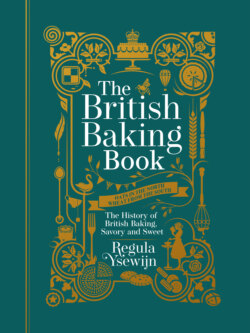Читать книгу The British Baking Book - Regula Ysewijn - Страница 16
На сайте Литреса книга снята с продажи.
Оглавление19
Cream and milk
I do like some fat and therefore also cream. The recipes in this book call for double cream, a British name for cream with a fat
content of at least 48 percent. In many countries full cream has a fat content of between 33 and 35 percent. Look carefully on
the packaging, choose the fattiest, and stay away from light versions.
The milk used in this book is always whole milk. If you are making cheese, I specify raw milk, which you can buy from
the farm and some markets. It has a very short shelf life because it is not pasteurized. You can also make cheese with sour milk
or milk to which an acid has been added, but you won’t have the exact result needed for these recipes because cheese made with
sour or soured milk is more acidic, while cheese made with raw milk is sweet. If you can’t find raw milk, it’s better to use ricotta in
recipes that ask for curd cheese.
Eggs
I use medium-sized organic eggs for my recipes. Eggs ensure that your cakes increase in volume and also add nutritional value, but
also make your cakes drier. The egg yolk gives your cakes a nice color. For the recipes, assume that one medium egg weighs around
50 g (1¾ oz).
Apricot kernels
In the past, bitter almonds were used instead of almond flavoring. These almonds contain a toxin that can be harmful if you eat
too many of them. Apricot kernels contain the same toxin but to a much lesser extent, making them a good alternative. Bashed
apricot kernels to which rosewater is added give the same marzipan-like odor and taste as bitter almonds. Adhere strictly to the
quantities in this book and do not eat the kernels without incorporating them into the bake. The kernels may not be eaten in any
case like regular nuts. Therefore keep them out of the reach of small children and housemates who are looking for something
to nibble.
Golden syrup and black treacle
Golden syrup and black treacle are two typical English sugar syrups that are by-products from the sugar refinery. Golden syrup
can be replaced by maple syrup or honey, while black treacle can be replaced by molasses, although the latter tastes much harsher
than treacle. You can also use honey for treacle, but then you will miss out on that beautiful dark color.
Candied citrus peel
In England this is simply called candied peel or mixed peel, and it is often a mix of candied lemon and orange peel. For convenience,
I have asked for candied citrus peel in the recipes – just use what you can find, unless it is specified in the recipe what kind of peel
is needed. A good citrus peel is equal to or thicker than ¼ inch. The skin must be sticky and not as tough and dry as candy. In some
recipes I also talk about candied cedro, which is a type of lemon with a very thick skin. This candied skin is usually pale yellowish
green and may be purchased from online sources.
Currants and raisins
Currants and raisins are often soaked for a few hours before use, but this isn’t preferable for all bakes. When it comes to some
cakes, fruit loaves, and buns, it’s better to use currants and raisins that haven’t been soaked. If you add soaked fruit to a bread or
bun dough, it will get damaged during the kneading process, and if you add it before shaping, it might introduce an unnecessary
amount of moisture to the dough, often making it annoyingly sticky. I prefer to work with a wetter dough that compensates for
the fact that the fruit isn’t soaked. I add the fruit before the first rise and it attaches itself perfectly to the structure of the dough.
You should, however, always rinse the fruit to remove any dust, and then pat it dry with paper towels.
